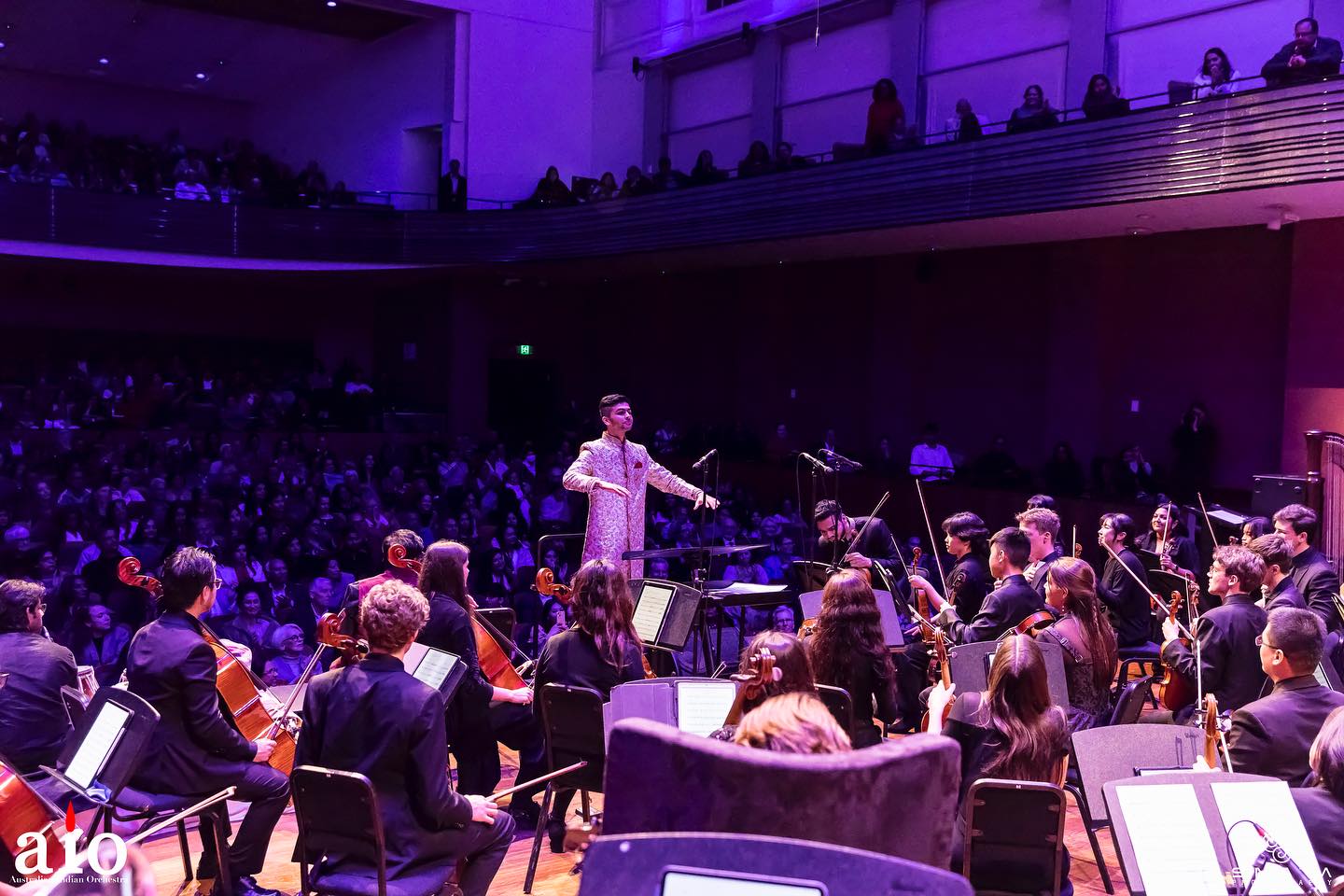(Aug 26, 2023) Sagar and Suraj Nagaraj, second-generation Australian immigrants, are the founders of the Australian Indian Orchestra (AIO), a pioneering initiative that marked its debut with the concert ‘Sydney to Mumbai: A Symphonic Journey to Incredible India’ – featuring a splendid 60-member symphony orchestra in Australia.
Their endeavour is rooted in their vision to cultivate a musical connection between the people of Australia and India and to present Indian music in western format. AIO harmoniously amalgamates Indian melodies with Australian orchestral arrangements, forging a unifying platform that brings together artists and audiences from both nations.

Concert of Australian Indian Orchestra at Sydney Conservatorium of Music
26-year-old Sagar and 20-year-old Suraj are musically inclined since their childhood. They have been giving performances at different platforms while growing up and enjoy a good fan following for their musical skills.
Fuelled by love for Bollywood
Despite being born and raised in Australia, Sagar and Suraj Nagaraj simply love Bollywood music, strongly influenced by their music loving parents. Sagar, shared, “Our childhood is filled with memories of returning home from school to the whistles of our father’s favourite Hindi songs.” He added, “We found Bollywood films constantly being watched on TV at our home.” The environment at home, ignited their passion for music since as far as they can recall.
As they grew up, they realised that Bollywood music wasn’t too popular beyond their home. The brothers, whose parents immigrated to Australia in 1993, started nurturing a shared dream – to introduce Bollywood music to Australia. With the launch of the Australian Indian Orchestra, they are now coming closer to make that dream come true.
Starting young
Sagar discovered his affinity for strings in school and subsequently took up the violin. Regularly participating in his school’s musical programmes, he captivated his music-loving parents by playing ‘O Saathi Re,’ a Bollywood tune he had heard his father whistle countless times. His father was pleasantly surprised by how beautifully Sagar played the melody.
Since then, listening to Indian melodies on Sagar’s violin became a regular pastime in the Nagaraj household. The younger brother Suraj, recalled, “I fell in love with the violin at the age of four when I heard Sagar play and begged my parents to get me one as well.”
Idea of orchestra
The idea of Australian Indian Orchestra’s formation germinated in their mind during a performance when the Nagaraj brothers intertwined select Hindi melodies with customary string orchestra classics to bring some variety. All the songs that they played received lots of appreciation from the audience that comprised of both Indian and Australian attendees.
Their enthusiastic response propelled the brothers to establish a new musical endeavour – the Australian Indian Orchestra, to showcase the fusion of musical styles.
Forging ahead with vision
Guiding the ensemble, Sagar assumes the role of concertmaster, meticulously crafting the concert’s line up by infusing his deep understanding of Indian music into every element. He describes the process as a combination of attentive listening, profound reading, meticulous note transcription, and dedicated practice. His visits to India and exposure to Carnatic music during trips to his native place Mysore has greatly impacted his approach. “It helped me a lot while writing the musical notes for the songs of AIO,” he shared. The youngster has also performed in Kochi as part of the Sydney Youth Orchestra in 2017.
While Suraj who has experience performing with the Australian World Orchestra holds the role of conductor. “String music has always featured in a big way in Bollywood music,” he said. “In most Hindi songs, you can hear a violin or a cello,” he added.
Diversity and magnificence
Their inaugural concert’s repertoire spanned a diverse range of songs by vocalists such as Mohammed Rafi, Kishore Kumar, Lata Mangeshkar, Hariharan, Shankar Mahadevan, Sonu Nigam, Shreya Ghoshal, and Arijit Singh. In addition to this vocal diversity, the performance showcased a varied instrumental ensemble, including tabla, sitar, santoor, guitar, piano, and keyboard, all contributing to the tapestry of orchestral magnificence.
For the Nagaraj brothers, Bollywood music resonates as their ‘home away from home.’ After their debut concert at Sydney Conservatorium of Music, they are busy preparing for their next concert to be held on the occasion of Diwali at Concourse in Chatswood, Sydney. They are aspiring to take their orchestra from Sydney to Mumbai in the coming days.




